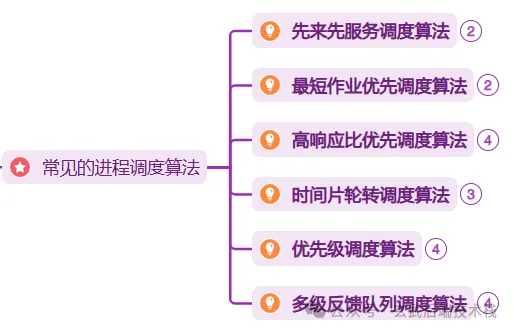
Overall Reading
1400
Words
Reading Time
5
Minutes

Prerequisite Knowledge
Difference Between Preemptive and Non-Preemptive Scheduling?
Non-Preemptive Scheduling: Once a process starts executing, the operating system will not allocate the CPU to other processes until the process voluntarily releases it.
Preemptive Scheduling: The operating system can forcibly pause the execution of a running process and allocate the CPU to another process. This means that even if a process has not completed its execution, the operating system can interrupt its running.
Common Process Scheduling Algorithms
First-Come, First-Served Scheduling Algorithm
-
Non-Preemptive (FCFS, First Come First Served) -
Processes are queued in the order they arrive, executing the process that entered the queue first until it completes or blocks, then proceeding to the next process in line. -
Disadvantage: If a long job is queued behind many short jobs, the long job will take a long time to execute, causing short jobs to wait longer, which is not favorable for short jobs.
Shortest Job First Scheduling Algorithm
-
Non-Preemptive (SJF, Shortest Job First) -
Shorter jobs are prioritized, which helps improve system throughput. -
Disadvantage: Not favorable for long jobs; when there are many short jobs, long jobs may not get executed.
Highest Response Ratio Next Scheduling Algorithm
-
Non-Preemptive (HRRN, Highest Response Ratio Next) -
This algorithm balances short and long jobs, calculating the priority/response ratio of each job during scheduling.

-
If thewaiting times are the same, the shorter service time has a higher response ratio, thusshort jobs are executed first. -
If the processes have the samerequired service time, the longer waiting time results in a higher response ratio, thuslong jobs are executed first. -
Disadvantage: Requires calculating priority each time, increasing system overhead.
Round-Robin Scheduling Algorithm
-
Preemptive (RR, Round-Robin) -
Uses time slices to allocate CPU time, allowing each process to receive response within a certain time interval, treating each thread equally. -
Time Slice: Each process is allocated a time period to run. -
If the time slice is too short, it will lead to frequent context switching, increasing system overhead. -
If the time slice is too long, it is not favorable for short jobs, leading to long response times for short jobs. -
Typically, the time slice is set between 20ms to 50ms.
Priority Scheduling Algorithm
-
IncludesPreemptive and Non-Preemptive (Priority Scheduling) -
Generally, scheduling is done based on process priority. -
Processes are scheduled based on urgency, usually dynamically adjusting the priority; if execution time is too long, the priority is lowered; if waiting time is too long, the priority is increased. -
Non-Preemptive: When a higher priority process appears in the ready queue, the current process completes before selecting the higher priority process. -
Preemptive: When a higher priority process appears in the ready queue, the current process is suspended, and the higher priority process is scheduled to run. -
Disadvantage: Lower priority processes may never get executed.
Multilevel Feedback Queue Scheduling Algorithm
-
Preemptive (Multilevel Feedback Queue) -
Multilevel: Indicates multiple queues, with priority decreasing from high to low, and shorter time slices for higher priority. -
Feedback: If a new process joins a higher priority queue, the currently running process is immediately stopped to allow the higher priority process to run. -
Multiple queues are set up, arranged by priority, with shorter time slices for higher priority queues. -
In the same queue, processes are scheduled using the round-robin algorithm. -
New processes will be queued in the higher priority queue; if not completed within the allocated time slice, they will switch to the next lower priority queue. -
Only when the high priority queue is empty will the next lower priority queue be called. -
When a process enters the high priority queue, the currently running process is stopped, placed at the end of its queue, and the high priority process is run. -
This algorithm accommodates both long and short jobs, providing good response times for both.
Previous Reviews
Alibaba Interview: How to Ensure Multiple Threads Execute in Order
Source Code Analysis of CGLIB Dynamic Proxy
Interviewer: Discuss the Underlying Principles of JDK Dynamic Proxy
JD Second Interview: Discuss Java Serialization and Deserialization
@ControllerAdvice Global Exception Handling Explained

Scan to Follow
Xuanwu Backend Technology Stack
Get More Exciting Information

Looking Forward to Your Shares, Favorites, Likes, and Views
